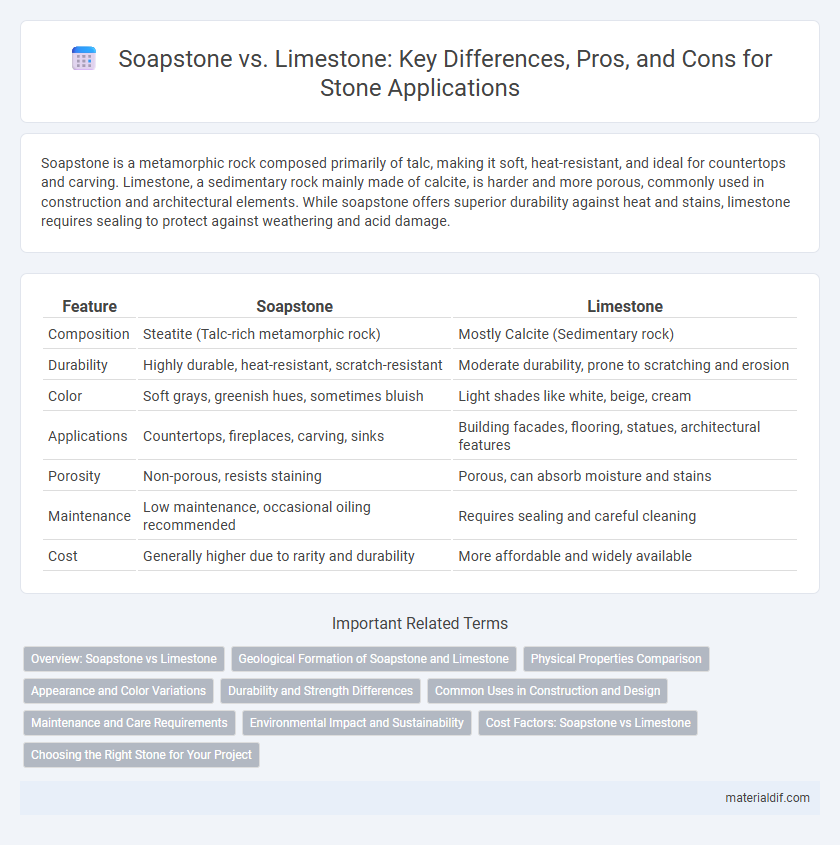Soapstone is a metamorphic rock composed primarily of talc, making it soft, heat-resistant, and ideal for countertops and carving. Limestone, a sedimentary rock mainly made of calcite, is harder and more porous, commonly used in construction and architectural elements. While soapstone offers superior durability against heat and stains, limestone requires sealing to protect against weathering and acid damage.
Table of Comparison
| Feature | Soapstone | Limestone |
|---|---|---|
| Composition | Steatite (Talc-rich metamorphic rock) | Mostly Calcite (Sedimentary rock) |
| Durability | Highly durable, heat-resistant, scratch-resistant | Moderate durability, prone to scratching and erosion |
| Color | Soft grays, greenish hues, sometimes bluish | Light shades like white, beige, cream |
| Applications | Countertops, fireplaces, carving, sinks | Building facades, flooring, statues, architectural features |
| Porosity | Non-porous, resists staining | Porous, can absorb moisture and stains |
| Maintenance | Low maintenance, occasional oiling recommended | Requires sealing and careful cleaning |
| Cost | Generally higher due to rarity and durability | More affordable and widely available |
Overview: Soapstone vs Limestone
Soapstone is a metamorphic rock primarily composed of talc, offering a soft, heat-resistant surface ideal for kitchen countertops and wood stoves. Limestone is a sedimentary rock mainly made of calcium carbonate, commonly used in construction, architecture, and sculpture due to its durability and ability to be polished. Both stones differ in hardness, porosity, and resistance to heat and acids, affecting their suitability for various applications.
Geological Formation of Soapstone and Limestone
Soapstone forms through the metamorphic alteration of ultramafic rocks rich in talc, chlorite, and serpentine under low-grade metamorphic conditions, resulting in its characteristic softness and heat resistance. Limestone primarily originates from sedimentary processes, composed mainly of calcite from marine organisms' skeletal fragments, accumulating in warm, shallow marine environments over millions of years. The geological formation of soapstone involves intense heat and pressure altering magnesium-rich minerals, while limestone develops through biological deposition and diagenesis of calcium carbonate sediments.
Physical Properties Comparison
Soapstone features a smooth, soapy texture with a Mohs hardness of 1 to 2.5, making it softer and more easily carved than limestone, which has a hardness of 3 to 4. Limestone exhibits a granular texture and higher density, providing greater durability compared to the porous and heat-resistant soapstone.
Appearance and Color Variations
Soapstone displays a smooth, often waxy texture with muted shades of gray, green, and brown, creating a soft, natural appearance ideal for countertops and carvings. Limestone features a granular surface with a broader color palette ranging from creamy whites and tans to warm beiges and subtle yellows, offering a classic and versatile look for both interior and exterior applications. The color variations in soapstone tend to be more uniform, while limestone's diverse mineral content results in more pronounced veining and pattern differences.
Durability and Strength Differences
Soapstone exhibits superior durability due to its high talc content, making it resistant to heat, stains, and scratches, while limestone is softer and more prone to erosion and surface damage. Limestone's calcium carbonate composition contributes to its susceptibility to acid etching and weathering, limiting its strength in outdoor or high-traffic applications. The denser, non-porous structure of soapstone provides greater longevity and strength compared to the more porous, fragile nature of limestone.
Common Uses in Construction and Design
Soapstone is commonly used for countertops, sinks, and fireplace surrounds due to its heat resistance and smooth texture, making it ideal for both functional and decorative applications in interior design. Limestone, valued for its durability and classic appearance, is frequently employed in exterior cladding, flooring, and architectural elements such as columns and facades. Both stones offer versatile options in construction, with soapstone favored for natural, heat-resistant surfaces and limestone preferred for structural and ornamental purposes.
Maintenance and Care Requirements
Soapstone requires minimal maintenance due to its non-porous nature, resisting stains and bacteria without the need for sealing. Limestone, being a porous sedimentary rock, demands regular sealing and careful cleaning to prevent stains and damage from acidic substances. Both stones benefit from gentle cleaning with mild soap and water, but soapstone is more forgiving and durable in high-use environments.
Environmental Impact and Sustainability
Soapstone demonstrates superior environmental sustainability compared to limestone due to its durability and lower processing emissions, which reduce carbon footprint over time. Limestone extraction often involves more intensive quarrying practices, resulting in greater habitat disruption and higher energy consumption. The non-porous nature of soapstone also minimizes the need for chemical sealants, enhancing its eco-friendly profile in construction and design.
Cost Factors: Soapstone vs Limestone
Soapstone generally costs more than limestone due to its higher density, durability, and unique heat-resistant properties, which make it ideal for countertops and carving. Limestone is more affordable and widely available, but it is softer and more prone to acid etching and scratching, leading to potentially higher long-term maintenance costs. The choice between soapstone and limestone ultimately depends on budget considerations and intended use, as soapstone's higher initial price reflects its longevity and low upkeep needs.
Choosing the Right Stone for Your Project
Soapstone offers exceptional heat resistance and non-porous qualities, making it ideal for kitchen countertops and fireplaces, while limestone provides a softer, more porous surface perfect for decorative applications and outdoor use. Consider the stone's durability, maintenance requirements, and aesthetic appeal based on your project's functional and design needs. Evaluating environmental exposure and intended use will ensure the right balance between beauty and performance.
Soapstone vs Limestone Infographic

 materialdif.com
materialdif.com